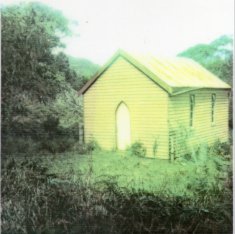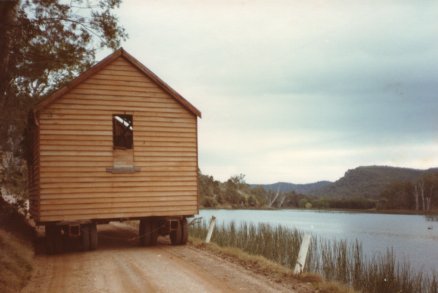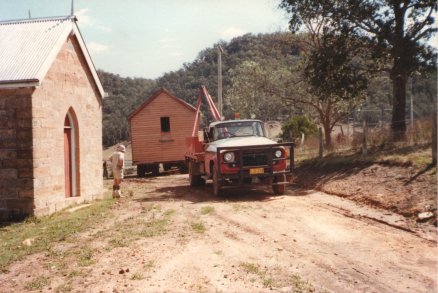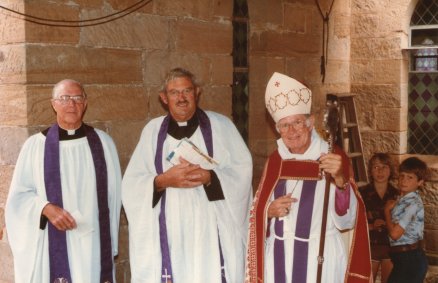Thanks to Fred Robinson and Ian Elton for the photograph, date unknown, and to Warren Bailey and Don McKillop for additional information.

The first Anglican worship in the Macdonald Valley took place in a school-house on the banks of the Macdonald River near the original (now historic) cemetery on Settlers Road. This was built by public subscription and its use for worship was secondary. The schoolmaster was also the sexton and he kept a boat to ferry across his pupils who lived on the opposite side of the river - and to do the same for bodies for burial, though their journey was one-way. What little we know of this comes from the diary of Mrs. Felton Mathews, accompanying her husband who surveyed the valley in 1833.
We passed the Burial Ground, a square railed enclosure, containing several graves, most of them surrounded with a neat paling: immediately opposite on the river's bank is the schoolhouse used as a church, and the cottage of the Sexton and Dominie, with a neat garden: these small rough buildings have a somewhat picturesque appearance, perched at the foot of the mountains whose rocky broken sides rise almost perpendicular and the narrow slope down to the water cultivated as a garden.It seems that she didn't attend church that year, but returning to her favourite campsite in 1834 and attending church her opinion of the picturesque building was somewhat downgraded:
The church was a small rough building of wood, thatched, and the sides plastered with mud, which had fallen out in many places, there was no floor, no windows; the desks and seats and pulpit all made of rough boards, such a place, as would not pass for a good barn in England.From Marjorie Hutton Neve, The Forgotten Valley, Library of Australian History, 1978
The first church at St Albans was proposed in 1842, and Thomas Thompson, Joseph Fernance, Charles Jurd, John Fleming and George Preston were appointed as trustees to oversee the construction. (The absence of any Baileys is surprising). A timber church was completed the following year and opened with great pomp with a service conducted by the Rev. Mr Simpson. However the building mostly functioned as a school-house and Sunday services were taken by the Rev Mr Pryce who was also the schoolmaster. It seems that the timber building burnt down, and a stone church was built in its place, but the date (probably circa 1863) is not clear. In 1878 the stone church was already reported to be 'somewhat out of repair', which seems surprising.
The church was rebuilt in 1896-1897 using "a good deal of stone from the previous church". The architect was Mr. S. Rigg and the builder was Mr. J.B. Stephens of Sackville Reach. The new church was inaugurated on the weekend of 6th-7th November 1897, but it was not entirely complete. In particular there were as yet no windows, the openings being filled with "wood cut to shape". Leadlight windows were planned and were estimated to cost £25, and the interior plaster was not yet painted.
On Saturday the 6th a grand entertainment was organized under the supervision of the Rev. F.A. Cavell, the incumbent. A 40-foot (12m) table was set up outside the church and 140 adults and 60 children sat down at 6pm to a tea prepared by the ladies of the parish. At 8pm all moved on to a musical performance in the church, but the crowd was too great and some 40 people had to listen from outside.
On Sunday 7th a service was held at 3.30pm and about 70 people attended. This was said to be three times the usual congregation but still seems rather poor when 200 had attended the party! Some things, it seems, never change.
New information researched by Rev. Peter Inman, largely from the Windsor and Richmond Gazette for Saturday November 20th, 1897, which you can read online here.
| There used to be an old wooden church, St John the Baptist, at Fernances, just beyond the northern end of the common. (It was often called 'the Common Church'). It was built in 1906 but fell out of use in the 1950s. (After the great flood of 1947 many people left the valley and congregations fell considerably. Older people say that the valley almost died.) By the 1980s St John's was in a very poor state, being used as a hayshed with a big hole in the roof, and all doors and windows missing. It belonged to St Alban's parish, and in 1983 Father John Price, the then Rector, proposed moving it lock, stock and barrel, to St Albans to be converted into a Church Hall. Thanks to Fred Robinson and Ian Elton for the photograph, date unknown, and to Warren Bailey and Don McKillop for additional information. |
 |
Luckily help was at hand since local resident Don McKillop had a business doing just this sort of thing, moving whole buildings from place to face. The stately progress from above the common to beside St Albans Church is documented below.
 |  |
| Coming through the Common, past the lake. | Passing the Settlers Arms. |
 |  |
| Nearly there. | Manoeuvring into position (note the hole in the roof). Halifax Hayes, in customary garb, in the foreground. |
This was only the start - the building needed a new roof, new windows (hall style rather than church style), new floor and so on. The late Halifax Hayes (see above), local builder and "character", played a large part in this. By the end of the year the transformation was complete, including a roofed walkway to the vestry door. The grand opening and consecration was held on the 3rd December, with Bishop Geoffrey Parker officiating.
 |  |
| The opening function - Holy Eucharist at 11am, followed by the formal consecration and then a 'bring a plate' lunch. | The officiating priests. Fr. John Price, centre, Bishop Geoffrey Parker, right. Can anyone identify the priest on the left - or the two kids extreme right? |